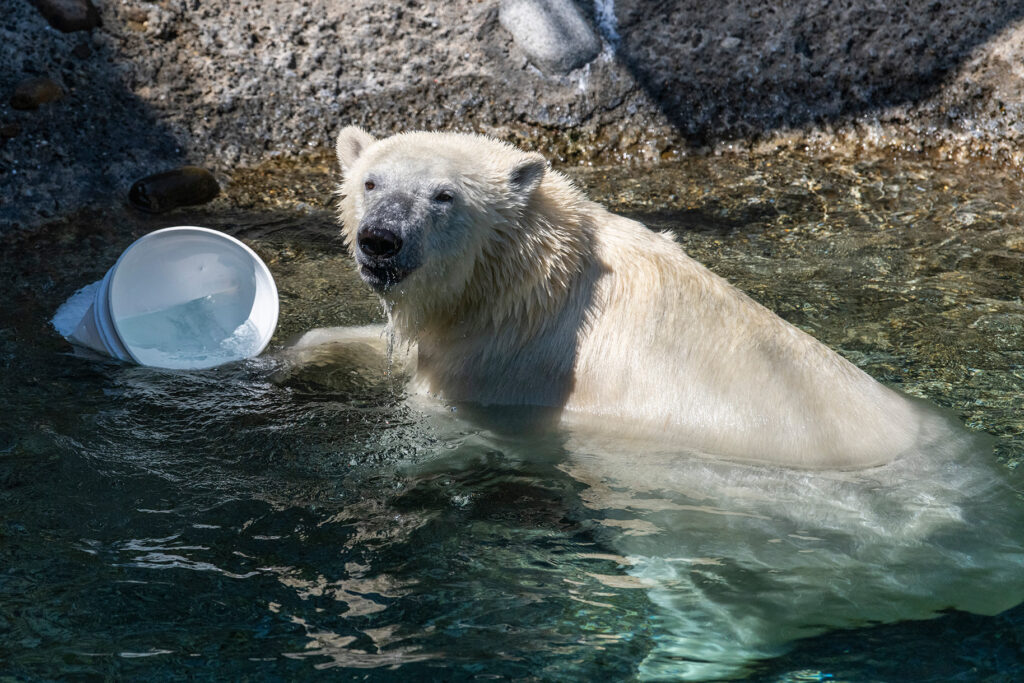Arctic Sea Ice Day is July 15. It’s a day to draw attention to the rapidly melting Arctic ecosystem, why it matters, and how we can all help slow this trend.
Point Defiance Zoo is home to polar bears, walruses, seals, and an Arctic fox, and they inspire us to care about their wild counterparts living in the Arctic that need sea ice to survive. Our goal is to encourage and empower members of our community to have solution-focused conversations about climate change.
We need to act now to save Arctic sea ice
The Arctic is now warming nearly four times as fast as the rest of the planet, causing the sea ice to melt.
- Scientists agree that Arctic sea ice will continue to decline over the 21st century if we don’t take action. Some climate models suggest the Arctic could be essentially ice-free as early as 2030 or as late as 2100.
- Satellite data tells us that we’re losing September sea ice – the lowest level in the year – at a rate of 32,000 square miles per year. That’s like losing an area the size of South Carolina.
- Arctic sea ice area has diminished by approximately 50 percent since 1979 and near-surface air temperatures in the Arctic have risen by more than 35.6°F, which is nearly three times as fast as the global average.
Arctic animals need sea ice to survive
The vanishing sea ice in the Arctic poses a significant threat to animals. Arctic foxes get stuck on land, facing fierce predators. Seals and walruses have nowhere to rest and have babies. Polar bears can’t find food.
Declining sea ice reduces the time polar bears can hunt seals, increases their fasting period, and forces them to rely on their fat stores for longer periods. If the Arctic continues to warm at the current rate, we will see fewer polar bears in fewer places across the Arctic. The International Union for the Conservation of Nature’s Species Survival Commission has even designated the species as facing a high risk of global extinction.
“The polar bears here at the zoo have an important role,” said Point Defiance Zoo & Aquarium General Curator Malia Somerville. “They inspire our community to take action in their own lives to reduce their carbon footprint and help protect polar bears in the wild.”
Point Defiance Zoo is a leader in polar bear research and conservation, working with Polar Bears International and other partners to help study and protect polar bears in the Arctic. As a certified Arctic Ambassador Center through Polar Bears International, the zoo supported a “Burr on Fur” study to test bear-friendly ways to attach tracking devices to help scientists study the movement patterns of wild bears. Additionally, zoo staff partnered with University of Washington scientists to study the rate of hair growth in zoo bears to evaluate stress levels, contaminant exposure and nutritional needs in wild polar bears.
Humans need sea ice, too
People also need sea ice – even if they live thousands of miles away.
Sea ice acts like a global air conditioner, helping to cool the planet by reflecting the sun’s light and heat back into space rather than absorbing it into the water. Just as a heart circulates blood and regulates the body’s temperature, the ocean controls the world’s climate system by circulating heat, moisture, and nutrients around the planet. Disruptions in this system, such as extra heat, have global impacts and can lead to changes in weather patterns and destruction of marine ecosystems.
That means an even hotter planet, and more frequent devastating weather events like fires and floods.
And those who live in the Arctic, like the Inuit and other Indigenous people, rely on it for food and transportation access.
The solution in a nutshell
Basically, we need to slow down our carbon emissions. Burning fossil fuels like oil and gas releases carbon dioxide into the atmosphere, which acts like a thick blanket trapping heat in and changing our climate. We can slow down our carbon emissions and protect sea ice by burning fewer fossil fuels. This will take global collaboration. But as individuals and local communities we can still play a big part.
The good news is, no matter where we live, steps we take in our local communities can have an impact on our global climate. Sign up to plant carbon-storing habitat locally at Tacoma Tree Foundation and Metro Parks Tacoma Chip-In.
Communities, companies, and governments are using their collective power to develop climate-friendly systems and practices. One powerful action you can take is to talk about our changing climate (especially solutions) with your friends, family, and colleagues. Sound daunting? Here are some helpful tips.
The information overload is real. Confusing and misleading headlines and unreliable sources can make the situation seem overwhelming. Visit our climate change page for trusted sources we recommend for climate news and information.
Finally, come visit our polar bears, Arctic fox, walruses and seals at the Arctic Tundra habitat inside the Zoo, and learn more about how you can help save the sea ice.
